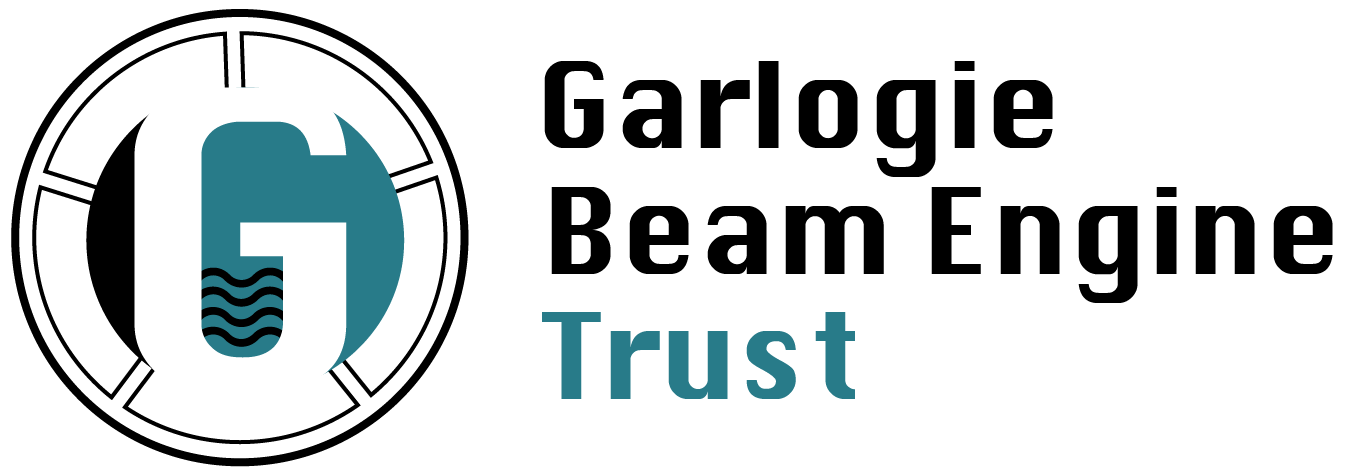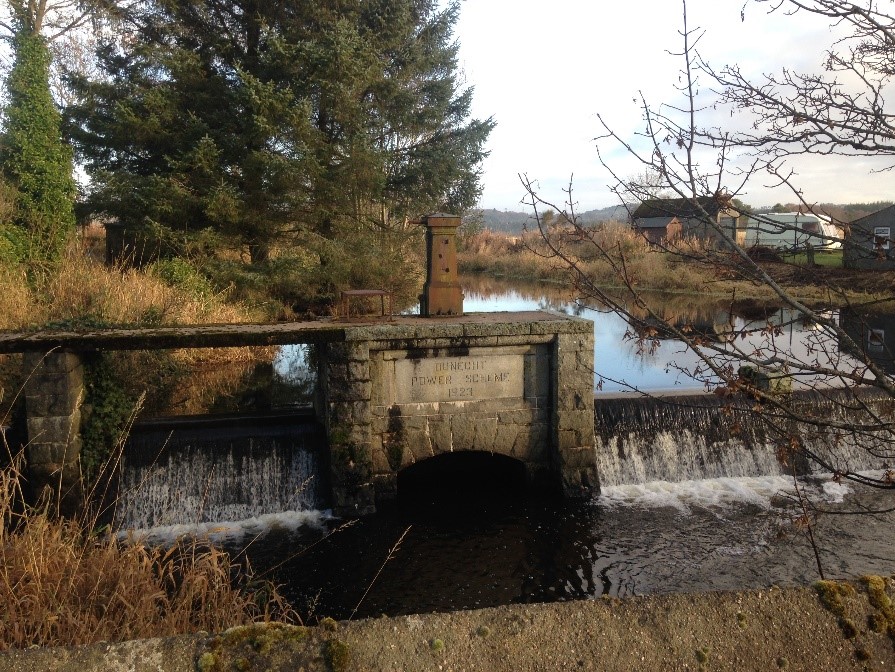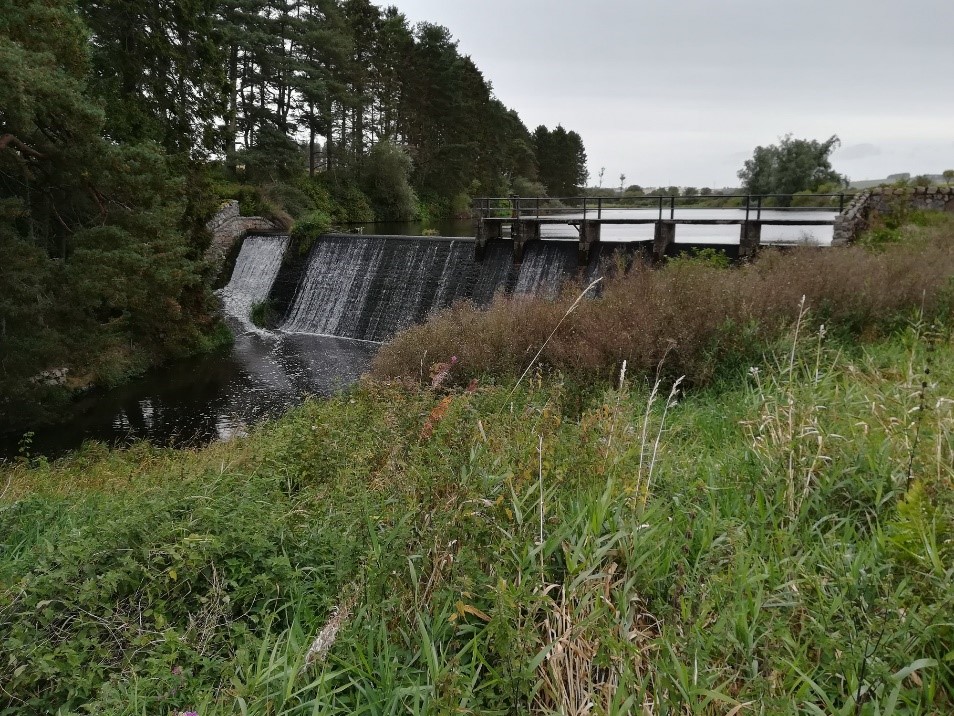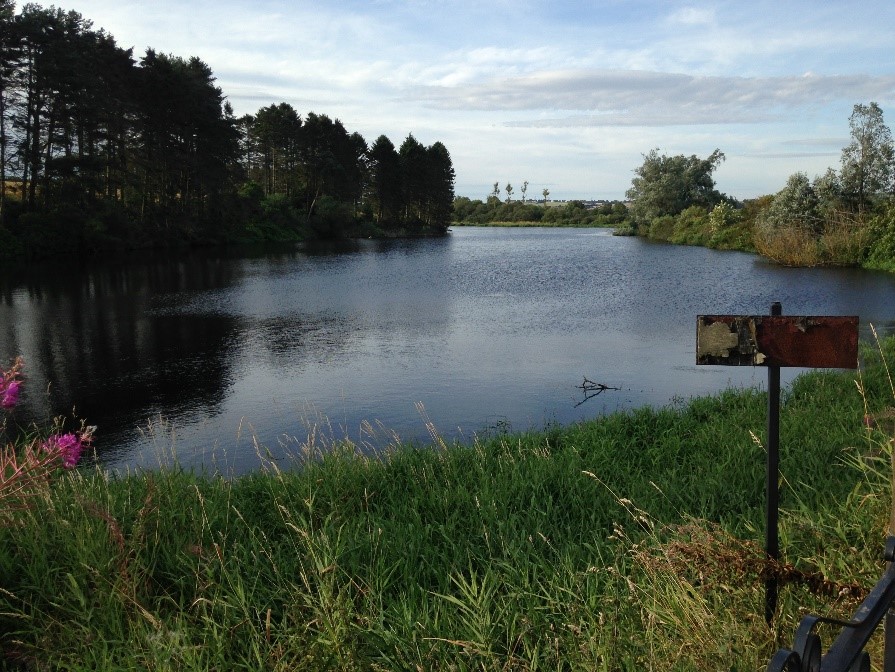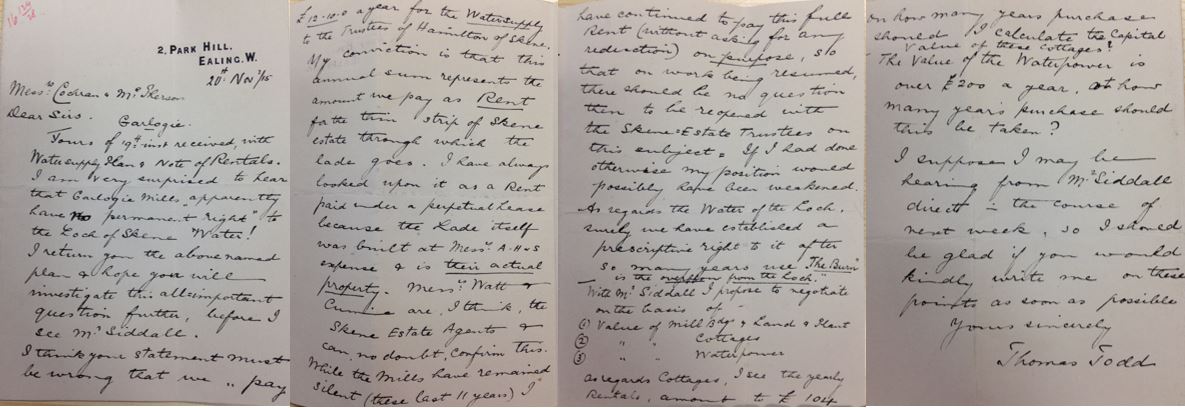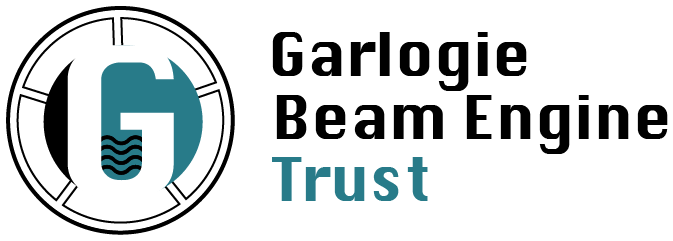Mill Water Power
Water power for Garlogie Mill comes from the Leuchar Burn which flows out of Loch Skene. In a map of 1789, there is evidence of 3 mills being in operation on the burn – one meal mill close to the outlet from Loch Skene, a waulkmill on the west bank about 300m downstream called Mill of Air, and another waulkmill called the Nethermill of Garlogie (ie lower mill) at what became the site of the Garlogie Mill. The waulkmills (known as a fulling mills in England) were driven by a water wheels, unfortunately, we have no details of the water wheel type or location.
In 1799 Thomas Black took over Garlogie waulkmill. His first act was to replace it with a large 3-story mill for wool carding and spinning, with the mill being powered by a waterwheel located inside the mill building. The new mill was fed by a new lade which took its water from the first Garlogie dam which was on the Leuchar burn about 50m upstream of the current road bridge next to Garlogie Cottages, providing a water-head of about 5.2 meters to the mill. A mound of rubble can still be seen adjacent to the burn where it once stood. The loch behind the dam (the first Garlogie Loch) extended up the Leuchar burn to just above the track leading to the collection of farm buildings at Netheron of Garlogie on the east side.
In 1827 a new lade was constructed which took water from much higher up the Leuchar Burn and transported it to Garlogie Mill with an improved head of 6.9 meters, significantly increasing the power available. At the same time, the waterwheel was replaced by a larger version, probably constructed of wrought iron, to harness the power for the mill machinery. When the mill was shut down (i.e. at night and on Sundays) the flow from the new lade was closed off at Garlogie Mill and diverted back down the old (i.e. pre-1827) lade to a location adjacent to Garlogie cottages where it discharged back into the Leuchar Burn.
In around 1890, the 1827 water wheel was replaced by a more efficient 18″ Hercules Turbine of 64 horsepower fed by the same lade as the waterwheel. The Hercules turbine was installed with its axis vertical in a tank contained within a small building just next to the North wall of the main mill building, two sets of bevel gears being used to transmit the power to the line shafting in the main mill. Today the Hercules turbine building can be seen at the West end of the power turbine building. Unfortunately, the turbine itself was removed at some point before the Lord Cowdray’s 1923 power generation equipment was installed. The extract from the 25-inch OS map of 1900 shows the routing of the mill lade at the time the turbine was operational, interestingly the turbine in it’s tank was directly coupled to an underground pipe attached to the end of the lade.
Following the sale of the mill machinery in 1905, Alexander Hadden and Sons kept the mill buildings and surrounding workers cottages in good condition in the hope of attracting a buyer for the site. This was a very protracted process as prospective users of the site were unsure of the water rights which had been a source of bother and dispute ever since the days of Thomas Black in the 1820s. Eventually, Thomas Todd (a cousin of the Haddens who had inherited responsibility for closing down Garlogie Mill) was forced to accept a low offer for the mill buildings from Weetman Pearson, 1st Viscount Cowdray, who in June 1918 had purchased the Garlogie portion of the Skene estates.
Lord Cowdray investigated various ideas for use of the site, including conversion to a sawmill, but eventually decided upon making use of the mill water supply to generate electrical power for Dunecht House and estate buildings. In the early 1920s work started on a significant upgrade to the Leuchar Burn to make it suitable for power generation. The outlet from Loch Skene was raised by a few feet by means of a new outlet sluice which was installed at Leadside near Milton of Garlogie. Just to the west of the farm at Milton of Garlogie a dam 5.7m high and 32.9m wide (the second Garlogie Dam) was constructed across the Leuchar Burn to create a large, shallow reservoir (the second Garlogie Loch) for the water supply to the power plant at the mill. An outlet low in the dam wall was created to carry water in a concrete pipe (called a penstock) laid along the course of the previous mill lade to a large surge tank just behind the Garlogie Mill buildings. This surge tank effectively served as an extension to the reservoir and supplied the water to the new hydro plant installed in a newly constructed turbine and generator building next to the beam engine house. Once water had passed through the turbine it was discharged via the course of the old mill outlet back into the Leuchar Burn. In August 2023 Lord Cowdray’s dam was partially demolished to facilitate the passage of salmon upstream for spawning, unfortunately, this means that restoration of the hydroelectric plant to power generation is now no longer possible.
The law relating to water rights in Scotland has always been a matter of Scots law and there has never been a UK-wide water law. Initially, Scottish landowners had full control over the use of the water from rivers and lochs on their land. There was also the legal principle of common interest which meant that if a river flowed through the lands of more than one owner, each landowner downstream was entitled to receive the same quantity and quality of water. From the 18th century, because of the importance of water power to the Industrial Revolution, the common interest rights of land owners with respect to river water became increasingly contested in the courts, with disputes continuing into the 19th Century. From the second half of the 19th Century, the situation began to develop due to the need for public water supply systems and in order to limit pollution, with some water rights being transferred to various public bodies.
The state of affairs was transformed between 2002 and 2013 when the Scottish Parliament passed various water supply acts in order to create an integrated public interest statutory framework for the management and use of water resources. These acts amongst other things created the Scottish Environmental Protection Agency (SEPA), which now has oversight over all abstractions, discharges, impoundments, and river works. The position today is that the water rights of land owners have been significantly reduced compared to the 19th Century, with the management of water resources no longer based on land ownership but being determined by the public interest. One wonders how the endless arguments about the mill water supply that blighted the lives of Thomas Black, Alexander Hadden, and Thomas Todd would have turned out differently had the current legislation been around at the time.
(*) Lade is the Scottish word for a millstream or watercourse. In England, the word leat would be used. A penstock is the word used when referring to a channel or pipe for conveying water to a hydroelectric power station
The letter below is one of the letters the beleaguered Thomas Todd wrote to his solicitor to complain about the unfairness of the water rights situation at Garlogie Mill.
Messers Cochrane and McPherson.
2, Park Hill,
Ealing W
20th Nov ‘/15.
Dear Sirs.
Garlogie.
Yours of 19th inst. Received with water supply and Note of Rentals.
I am very surprised to hear that Garlogie Mills apparently have NO permanent “right” to the Loch of Skene water! I return your above named plan and hope you will investigate this all important question further, before I see Mr Siddall.
I think your statement must be wrong that we pay £12-10-0 a year for the water supply to the Trustees of Hamilton of Skene. My conviction is that this annual sum represents the amount we pay as rent for the thin strip of Skene estate through which the lade goes. I have always looked upon it as a rent paid under a perpetual lease because the lade itself was built at Messrs A.H & S expense and is their actual property. Messr’s Watt and Cummins (?) are I think the Skene Estate Agents and can no doubt confirm this.
While the mills have remained silent (these last 11 years) I have continued to pay this full rent (without asking for any reduction) on purpose, so that on work being resumed there should be no question then to be reopened with the Skene Estate Trustees on this subject. If I had done otherwise my position would possibly have been weakened. As regards the water of the Loch, surely we have established a prescriptive right to it after so many years use. The Burn is the overflow from the Loch.
With Mr Siddall I propose to negotiate on the basis of (1) Value of mill buildings and land and plant; (2) Value of mill cottages; (3) Waterpower. As regards cottages, I see the yearly rentals amount to £104, on how many years purchase should I calculate the capital value of these cottages? The value of water power is over £200 per year, at how many years purchase should this be taken? I suppose I may be hearing from Mr Siddall direct in the course of the next week, so I should be glad if you would likely write on these points as soon as possible.
Yours sincerely
Thomas Todd.
